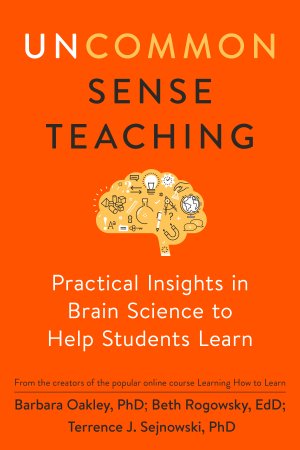Applying Insights From Neuroscience in the Classroom
A deeper understanding of how the brain works can help teachers plan lessons that reach every student.
Your content has been saved!
Go to My Saved Content.Understanding, even minimally, how the brain works when it comes to learning can help teachers more effectively educate students. In her recently released book, Uncommon Sense Teaching: Practical Insights in Brain Science to Help Students Learn, Dr. Barbara Oakley and her coauthors provide easy-to-understand explanations of neuroscience concepts and practical tips for how teachers can help students learn more effectively no matter what the content. I recently met with Dr. Oakley and learned about some of the neuroscience concepts on which her book is based, as well as practical advice for how teachers can apply this information in the classroom.
Understanding Working Memory
As explained in Uncommon Sense Teaching, we can think of information as a collection of balls. (Metaphors are a powerful tool to help our brains hold on to information.) Information is kept alive in working memory, a temporary mental storage space, by focusing on or repeating ideas. Students can hold on to only so much information consciously in their working memories. A typical working memory can hold, or work on, only about four balls of information at once. Long-term memory’s ability to hold on to information is just that—longer.
Special education teachers and learning specialists are well aware of the effect that working memory capacity can have on a student’s ability to learn. However, Dr. Oakley and her coauthors noticed that these ideas are often not applied to general classroom teaching practices. “We would like to think that this is common knowledge among all teachers, but, at present, it isn’t,” Dr. Oakley said when I spoke with her. Even in a single class, working memory capacity among students can vary dramatically. For example, students with a lesser-capacity working memory often have trouble completing multistep directions, or they may omit or repeat words when writing a sentence.
“As teachers,” Dr. Oakley told me in our interview, “we need to help kids realize that if you can’t understand something the first time you sit down to try, that doesn’t mean you are some kind of dummy. It just means that you are a member of the human race. Creating neural structures in long-term memory is what levels the playing field, so that a person with a low-capacity working memory can perform just as well as, or even better than, a person with high-capacity working memory.”
Simple teaching techniques such as pausing periodically during a lesson to give students a chance to reread or displaying multistep directions so that students can free up working memory capacity for actual lesson content can show tangible results for those with lesser-capacity working memory.
Declarative Versus Procedural Pathways to Learning
Similar to differences in working memory capacity, pathways through which we teach and learn knowledge can vary. There are two main pathways the brain uses to deposit new information in long-term memory. The declarative pathway is often thought to involve facts or events. The procedural pathway involves learning complex patterns, such as those found in mathematics, or skills such as typing, tying a shoe, or solving a Rubik’s Cube.

“Teachers need to know that both ways of learning are valuable and provide a deeper way for students to understand material,” Dr. Oakley said. “When teachers emphasize only one system of learning, as by forcing students to explain declaratively every step in solving a problem, for example, it can make it more difficult for a student to be a successful overall learner. We are hurting students who learn well procedurally. This type of learning is often difficult or impossible to explain.”
Offering opportunities for both declarative and procedural learning is key. One-minute summaries, where students write down everything they remember immediately following a lesson, or peer teaching, where students work with partners to teach one another facts and information from a lesson, are great ways for students to plug declarative information into long-term memory. Alternatively, teaching through procedural pathways requires the ability to practice, and actual practice of a skill helps automatize the information. Incorporating classroom activities that involve both types of pathways will optimize learning for all students.
Focused Versus Diffuse Modes of Learning
Another important aspect of brain science is understanding focused versus diffuse modes of thinking. When the brain is in focused mode, working memory is hard at work. It’s making neural connections and building an understanding of the material. Studying for a test, reading a text, or reviewing vocabulary in a foreign language are all examples of the brain working in focused mode.
In diffuse mode, the brain is less focused on the material. Instead, it’s making subconscious connections to the material. Daydreaming while going for a walk or letting your mind wander while taking a shower are examples of the brain in diffuse mode. Optimal learning often involves both focused and diffuse modes of thinking. Teachers can guide students to recognize these two forms of learning. For example, when students study, they can begin to recognize the point at which they become frustrated. That’s the point at which their focused mode is essentially maxed out. Taking brain breaks at this stage will switch their thinking to diffuse mode when neural links can begin to connect. As Dr. Oakley writes in Uncommon Sense Teaching, “Knowing when frustration has just reached a peak, so it’s time to switch to something else or take a break, is a valuable learning meta-skill. It comes in particularly handy on tests, where students often can’t unstick themselves once they become stuck on a problem.”
Dr. Oakley is a passionate educator who wants the best for both teachers and students, and is developing an online course for teachers. “Teachers are heroes,” she told me. “We wrote this book to help them teach even better and to help students excel in the subjects that can be the most difficult to learn.” While many of these strategies may not seem novel to teachers, thinking of them in terms of the neuroscience concepts they employ can guide teachers in making thoughtful, science-based decisions when planning lessons and units.
